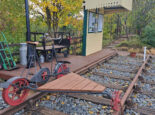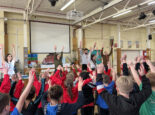Peterborough Tales
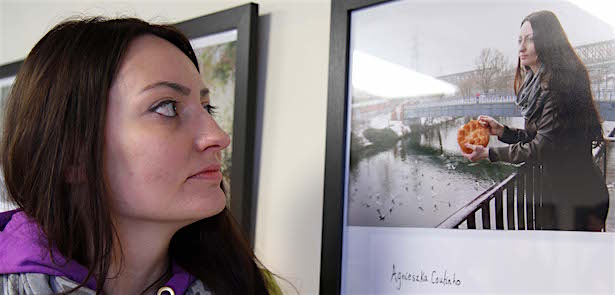
In 2011, Ben Rogaly – a lecturer at the University of Sussex – arrived in Peterborough on a mission: to explore the city’s migrant experience through the stories of people living here. Eight years later he had collected a hundred stories, made lifelong friends and seen the project go in directions he had never anticipated, encompassing theatrical performances, photographic exhibitions, a film, a tea party and culminating in the new book Stories From A Migrant City. The Moment talked to him about the experience, what it revealed and why it may be important.
How did the project first come about?
In 2010 a national open competition was advertised for a grant to do research in Peterborough, funded by the Arts and Humanities Research Council. The research would be a collaboration with Peterborough City Council and the Royal Society of Arts. I applied. Peterborough was the other side of East Anglia from Norwich where I had lived and worked for seven years – I wrote a book about Norwich too but that’s another story. Peterborough was also home to people working in the Fens in fields and food factories, whom I had met while doing research about working conditions in supermarket supply chains in the region. I visited the city several times after seeing the advertisement for the research grant and was struck by organisations there with a track record of anti-racism and welcoming international migrant workers. Peterborough is a place with a long history of migration, from both within and beyond the borders of the UK. It seemed an important place to listen to people’s stories and think about how people get on together – or not – and to look at how they make their own city. I called the project Places for All? (www.placesforall.co.uk). In March 2011, when I found out I’d got the grant to cover two years research, I was excited. I moved to live in the city part-time. I lodged in Fletton three days a week, bought myself a second-hand bike and cycled around Peterborough’s incredible cycle ways, getting to know different neighbourhoods, asking people to tell me their stories – of living in the city, of living in other places, what Peterborough and their neighbourhood meant to them. I was also interested in people’s working lives, both paid and unpaid, in the home and outside it.
What was the process?
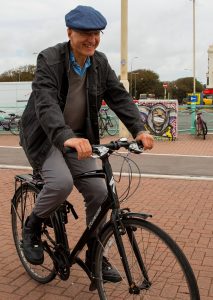 I worked like this for a solid nine months, and in the end collected over a hundred stories. I worked with a colleague Kaveri Qureshi and she did about a third of the 76 oral history interviews that we actually recorded – some were gathered from elsewhere, such as the British Library’s Millennial Memory Bank and other places. I don’t claim to be somebody who has become an expert on Peterborough, though – there are many local historians who know far more than I do. What I was doing is much more about listening to people’s stories and looking at an English city through that lens, learning about wider national and international issues at the same time, and also respecting the fact that the stories are woven into and emerge out of histories of particular places, within Peterborough and beyond.
I worked like this for a solid nine months, and in the end collected over a hundred stories. I worked with a colleague Kaveri Qureshi and she did about a third of the 76 oral history interviews that we actually recorded – some were gathered from elsewhere, such as the British Library’s Millennial Memory Bank and other places. I don’t claim to be somebody who has become an expert on Peterborough, though – there are many local historians who know far more than I do. What I was doing is much more about listening to people’s stories and looking at an English city through that lens, learning about wider national and international issues at the same time, and also respecting the fact that the stories are woven into and emerge out of histories of particular places, within Peterborough and beyond.
You mentioned there was two years initial funding but it ended up going on for a lot longer. What was the timeline?
My first trips to Peterborough were in 2010, and I was officially doing research from March 2011. It was funded by the Arts and Humanities Research Council for the first two years. I carried on visiting Peterborough regularly after that as I was writing articles based on the research. As part of a later Arts and Humanities Research Council-funded project, Creative Interruptions, which began in 2016, Jay Gearing and I made the film Workers, which was based on the experience of people working in Peterborough’s warehouses and food factories. This was done in 2017 and 2018, and those interviews then also became important in the book. From 2016 Metal Peterborough offered me the unpaid position of Writer-in-Residence, and that provided a fantastic base for finishing the book. The book itself was contracted in 2017, but I carried on visiting Peterborough – to interview people, but also because I had developed friendships there – until 2019. Overall it’s fair to say it was an eight-year period of research.
How were you received by local people?
I met so many generous people who were interested in being part of the research. I also encountered organisations like New Link on Lincoln Road, which had won a national award for its work with new international arrivals. But I also made contact through Jawaid Khan at Peterborough City Council with Peterborough Racial Equality Council, which was doing important anti-racist work in the city, and with individuals like Mahebub Ladha, Alison Davies and Mostyn Davies. On my early visits I was inspired by how the City Council and faith organisations – Muslim, Christian, Sikh and others – worked together to basically shut down the city centre when the English Defence League came to hold a rally. There was some understandable criticism by those who would have liked to have seen a bigger counter-protest, but overall I was really inspired by the way those organisations managed a difficult situation. It actually took me back to my teenage years in London, going to Rock Against Racism marches. I don’t want to make Peterborough out to be perfect. Structural racism exists there as much as anywhere else in England, but what was interesting was the innovative and creative way that local organisations were working together to counter racism in all its forms, to make the city a place where lots of people from different backgrounds with different histories could live together. Recently, the Diaspora Arts and Education Against Racism organisation made murals in the city that have gained international attention, including being tweeted by rappers Ice T and Chuck D.
People tend to think of academic research as rather dry and dusty, but this led you into some unexpected areas…
As part of the project I was able to work with a number of artists, initially from outside, but later artists who were Peterborians. They included a theatre maker, a pair of filmmakers and a photographer. We wanted to try and bring the oral histories to life, so it wasn’t just a research project trying to find out about something, it was something in which the people who were telling their stories could come together, sometimes for a play, sometimes for an exhibition, and sometimes in ways that enabled them to share what it was like to tell their story and what that made them feel about the city. One thing we did in 2012 was to organise a tea party in Chauffeur’s Cottage – which soon after became the base for Metal Peterborough. It was really driven by a couple of people from Peterborough, Jabeen Maqbool and Parveen Ashraf. I’d been planning something else – an exhibition of photographs in a gallery – but these two people, as well as Keely Mills and Zain Awan said: ‘What we need is to get people together so they can get copies of the photographs and quotes from their oral histories…’ So, people got to mingle together – young people, older people, people born and brought up in the city, newcomers, people of all ethnicities. That was really exciting. There is a video of it on YouTube, made by Zain Awan. Jabeen designed and organised the event, and Parveen, who has a column in the Peterborough Telegraph as Parveen the Spice Queen, catered for it, putting together a huge spread. Some of the young, white British actors, who lived in the Ortons, and had been part of the play we did, learned a lot about other parts of the city, and about south Asian heritage communities and about older generations through the oral histories. People were learning about each other, having conversations with each other that wouldn’t have happened otherwise. So, there was some action involved in this project; it wasn’t just an academic researcher coming in, gathering data and running off never to be seen again!
And I felt the work was really cared about by so many people. One day, we were supposed to have a photographic exhibition at the Posh ground. It was meant to coincide with the car boot sale but it was just tipping with rain so the car boot didn’t take place, but we went anyway and set up the exhibition. And Peterborough photographers came – Zain Awan, Chris Porsz, Peter Oliver – and they took photos of the exhibition. It felt so much like a shared project. And so did the play, which rehearsed in a mosque and performed in a church, at the Green Backyard and in the Posh ground – places people would ordinarily go. All that created new conversations.
Was the book always one of the end goals?
I always hoped to write a book, but didn’t know if I’d be able to. Also, there was a slight change of plan part way through. In 2016 I was talking to another publisher about what would have been a very academic book, about the relationship between oral history and geography. But the more I thought about that, the more bored I was! I didn’t feel energised or excited by the prospect of writing it – but I did feel energised and excited by what was happening in Peterborough around people and organisations that I knew, like the Gladstone Community Association, which does ESOL classes for adults. At their AGM there were over 100 people graduating, and an incredible atmosphere – people from all kinds of backgrounds.
I also wanted the book to be of interest to people way beyond academia. That was always my wish – and that’s another reason why I changed tack. It was a key moment in 2017 when Manchester University Press agreed that the contract should be for a paperback. Most academic books are hardbacks at a price that only libraries can afford, but this meant that people could buy it if they wanted to, and that makes a huge difference to me. There will be people reading it who may not be interested in the more academic sections but who might be interested in the stories. There have been some really nice things said about the stories. People who have had similar experiences to those telling their stories have come back to me and said how much they enjoyed them, and that’s very satisfying. I’m as interested in that as I am in how other academics respond to it.
Did Brexit, with its many debates about immigration, also have an impact on the direction you were taking?
The referendum was such a massive thing. And it wasn’t just the intensity of debates about immigration, but also issues of racism and certain communities becoming demonised. With the whole Brexit debate and the divisions over that, there was something important that I wanted to say, which was about how common it is to have an experience of moving place, whether between countries or within a country, and even if you haven’t had that experience the place that you live in can and does change around you. That whole connection between people, around the issue of migrating or staying still, seemed to me to be something that could bring people together. In these times it seemed very important to do that.
But I don’t see this as a ‘Brexit book’ – and I think it’s important to emphasise that I didn’t want the book to add to the divisiveness. People voted Remain or Leave for a whole range of reasons, and a whole range of people voted for each of those things. If someone seeks to demonise another group, I am quick to speak out against that. The campaigns, on the other hand, were both problematic. I just don’t want the book to be caught up in that, because its purpose really is to question the ways immigration is talked about. What’s really at the heart of this book is stories. We all have stories, and many of the people who recorded them got pleasure from having someone who was going to listen to it and value it.
Did this help people who are marginalised feel in some way validated?
There have been people who have felt validated reading the book. But there’s also a validation of people in general, and of Peterborough residents in general. Those might be people who have lived in the city all their lives or people who have recently arrived. The very first quote in the book is about the relation of people already living in Peterborough to the newcomers from London at the time of the new town, who were mostly white, British people. One of the chapters opens with five or six pages based on the story of one person – Charles Wood – who was born and brought up in Britain but was stigmatised as a ‘fair boy’ because he was a Traveling Showman. But also he’s been a successful businessman. He really enjoyed the process, but said that’s how he wanted to be portrayed, as a successful businessman, not the ‘poor fair boy’.
Then there’s someone who is an international migrant like Agnieszka Coutinho, who I quote from in chapter five where I’m talking about Peterborough books – I actually quote from her interview with you in The Moment! She’s one of many people who has played a part in making the book – and it really is a collaborative effort.
Another great example is Ron Singh, whose story opens chapter two. He grew up in the Gladstone area and talks about how much the multi-racial aspect of that area was taken for granted by him as a child, and then about the very different experience of going to school in a mainly white area. But also he talks about the mix of musical influences he got from his parents – his dad’s passion for Hindi film music and his mum’s passion for Elvis – which ends up with him becoming a founding member of the band Kissmet. That’s just one example of the many cultural things that Peterborough gives to the world! There’s also the work of Chris Porsz, who has very kindly allowed me to use one of his photographs on the cover of the book – and he’s already internationally known. I learned a lot from the cultural work that is produced by people in Peterborough. People elsewhere may not know about the place, or may have a negative image of it because of some press coverage, but that’s something that these stories really contest.
Do you think this will be good for Peterborough?
I hope people in Peterborough will read and enjoy the book as much as people elsewhere. I’m grateful for the time I spent with people in the city and especially to people who recorded their stories as part of the project. I hope to carry on visiting friends I made in the city throughout my life. Peterborough has changed me, and I’m really thankful for it.
PHOTOS: CHRIS PORSZ
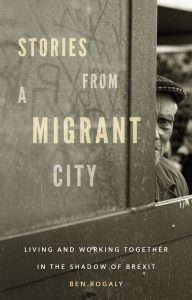 Stories from a Migrant City: Living and Working Together in the Shadow of Brexit can be purchased via the Manchester University Press website for £10 plus £2.50 P&P using the promotional discount code Stories50.
Stories from a Migrant City: Living and Working Together in the Shadow of Brexit can be purchased via the Manchester University Press website for £10 plus £2.50 P&P using the promotional discount code Stories50.
manchesteruniversitypress.co.uk
To see Zain Awan’s video of the tea party, go to: www.youtube.com/watch?v=8I-21FRcqhY
To see Jay Gearing’s film Workers, go to: creativeinterruptions.com/workers









